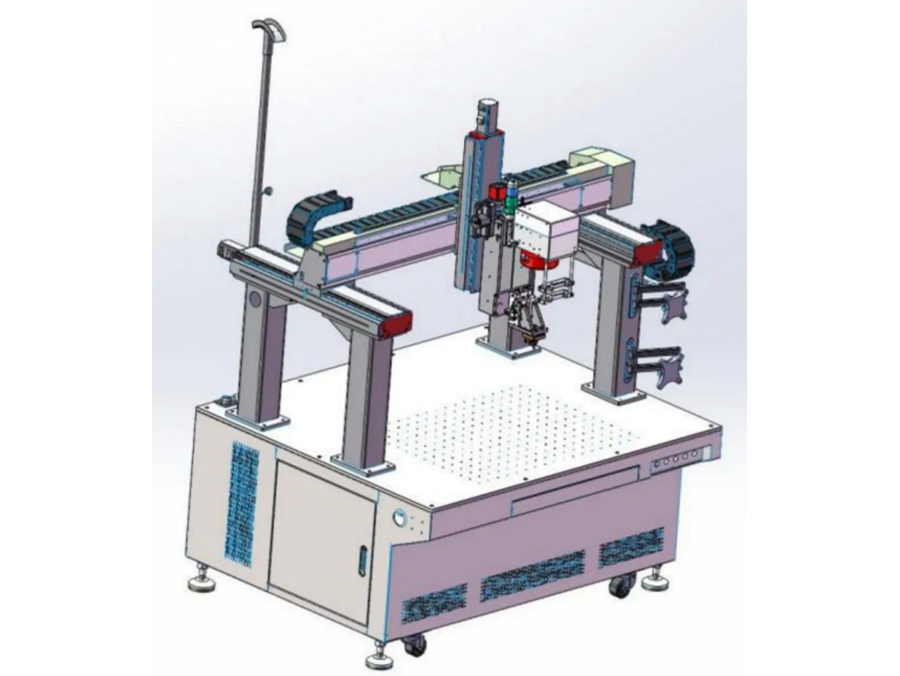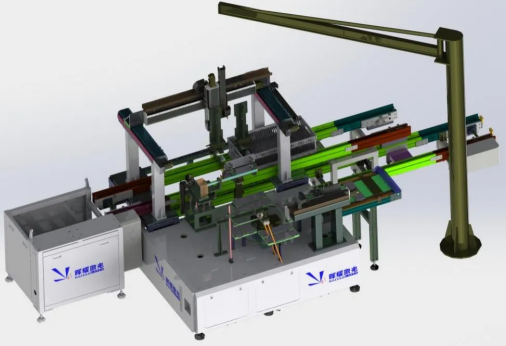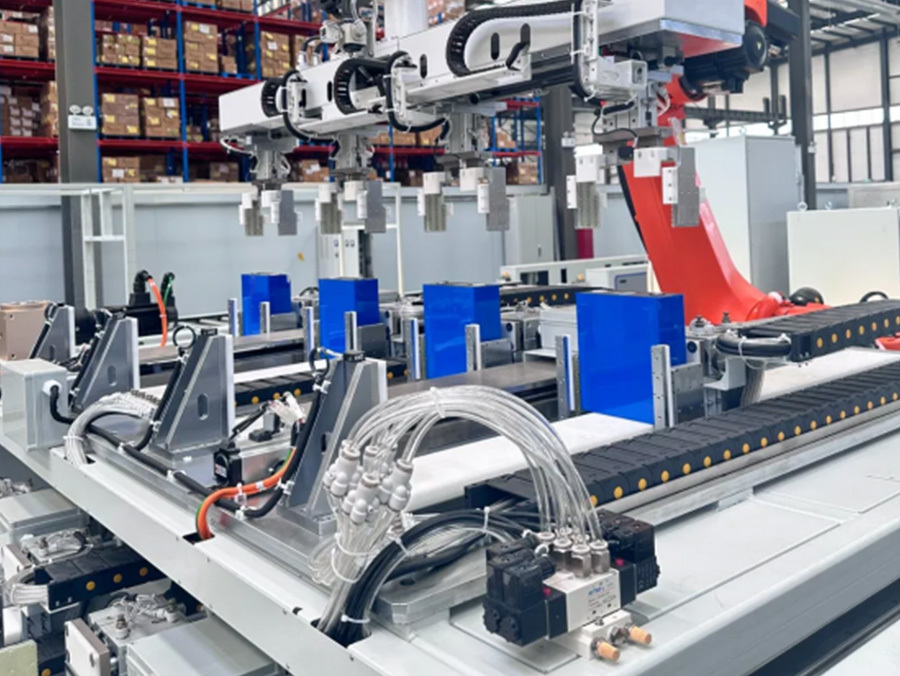Solution

Battery Terminal Tab Transition Sheet Welding Equipment
- Product description
-
- Commodity name: Battery Terminal Tab Transition Sheet Welding Equipment
- Commodity ID: 电池转接片焊接设备
Specialized for high-precision welding of battery terminal tabs to transition sheets in lithium-ion battery manufacturing. Supports multi-layer material welding with consistent bonding quality.
1. Equipment Overview
- Equipment Name: Battery Terminal Tab Transition Sheet Welding Equipment
- Model: HY-TTW6060
- Application: Specialized for high-precision welding of battery terminal tabs to transition sheets in lithium-ion battery manufacturing. Supports multi-layer material welding with consistent bonding quality.
2. Mechanical Specifications
- Equipment Dimensions:
- Length: 1600 mm
- Width: 1200 mm
- Height: 2100 mm
- Weight: 1500 kg ± 5%
- Frame Material: Industrial-grade steel frame with anti-corrosion treatment.
- Worktable Material: Hardened stainless steel with anti-static and wear-resistant coating.
- Motion System: Precision servo-driven X-Y-Z axes with linear guide rails.
3. Welding Specifications
- Welding Technology:
- Laser Welding (standard).
- Laser Type: Fiber laser, 1064 nm wavelength.
- Laser Power: 3000–6000 W (adjustable).
- Spot Size: 0.1–0.5 mm (configurable).
- Welding Speed: 5–12 welds per minute, depending on material and thickness.
- Welding Accuracy: ±0.05 mm.
- Transition Sheet Compatibility:
- Thickness: 0.1–1.5 mm.
- Materials: Aluminum, nickel, copper, and laminated sheets.
- Tab Compatibility: Aluminum, nickel, copper, and multi-layer combinations.
4. Vision and Alignment System
- Alignment Accuracy: ±0.03 mm.
- Camera:
- Type: Industrial-grade high-resolution CCD camera.
- Resolution: 5 MP.
- Lighting System: Adaptive LED illumination for consistent weld seam visibility.
- Error Detection: Automated detection of material misalignment, contamination, and weld defects.
5. Control and Interface
- Control System: Welding control card based with integrated HMI(Human Machine Interface).
- Interface:
- 19-inch display with intuitive user interface.
- Multi-language support (English, Chinese, others).
- Programmable Parameters:
- Laser power, duration, and spot size.
- Weld patterns and sequences.
- Recipe management for different battery models.
- Data Logging:
- Internal Capacity: 1 TB SSD for weld history storage.
- Export Formats: CSV and PDF via USB, Ethernet, or Wi-Fi.
6. Electrical Specifications
- Power Supply: AC 380V ± 10%, 50/60 Hz, 3-phase.
- Maximum Power Consumption: 36 kW.
- Control Voltage: 24V DC for internal systems.
7. Safety Features
- Emergency Stop: Dual redundant emergency stop buttons.
- Overload Protection: Automatic shutdown upon detecting overcurrent or excessive force.
- Laser Safety: Enclosed laser operation with Class 1 protective casing and interlocks.
- Temperature Monitoring: Real-time monitoring of weld area and cooling system.
8. Environment & Installation
- Operating Environment:
- Temperature: 10–30°C
- Humidity: ≤65% RH (non-condensing).
- Noise Level: ≤75 dB during operation.
- Installation Requirements:
- Flat, vibration-free surface.
- Minimum clearance: 800 mm on all sides.
9. Cooling System
- Type: Water-cooled laser module with independent chiller.
- Cooling capacity: 18KW
- Flow rate: 65L/min
10. Optional Configurations
- Dual Welding Heads: For increased productivity and simultaneous processing.
- IoT Connectivity: Remote monitoring and diagnostics via cloud platform.
- Custom Transition Sheet Molds: For non-standard sheet sizes and shapes.
- Integrated Pre-Weld Cleaning: Ultrasonic or laser cleaning module to ensure material surface quality.
11. Maintenance and Warranty
- Maintenance Schedule:
- Weekly: Clean lens, inspect worktable, and check laser alignment.
- Monthly: Inspect servo motors, cooling system, and electronic connections.
- Quarterly: Full calibration of alignment and welding systems.
- Warranty Period:
- Standard: 12 months.
- Extended: Up to 36 months upon request.
Key words:
Battery Terminal Tab Transition Sheet Welding Equipment
Series of Products
Huiyao Laser is a leading battery laser welding machine manufacturer offering professional battery pack and battery module welding solutions for many fields, such as energy storage systems of research and development machines, as well as complete assembly lines for module and battery pack production.
Comprehensive Pouch Battery Module PACK Automatic Production Line for Efficient Output 12PPM is designed for the modular production of solid-state batteries, featuring high automation, flexibility, and integrated quality control (QC) systems. It ensures efficient production while maintaining strict quality standards. The line is suitable for electric vehicles, energy storage systems, consumer electronics, and more, supporting the production of various specifications of solid-state battery modules.
Comprehensive Pouch Battery Module PACK Automatic Production Line for Efficient Output 12PPM is designed for the modular production of solid-state batteries, featuring high automation, flexibility, and integrated quality control (QC) systems. It ensures efficient production while maintaining strict quality standards. The line is suitable for electric vehicles, energy storage systems, consumer electronics, and more, supporting the production of various specifications of solid-state battery modules.
Huiyao Laser Fully-Automated Energy Storage Prismatic Battery Module PACK Line
Huiyao Laser Energy Storage Automatic Prismatic Battery Module PACK Line is an efficient, intelligent and customized automated production line, specifically designed for the energy storage field. It is suitable for application scenarios such as large - scale energy storage systems, home energy storage, and industrial energy storage. This production line integrates advanced laser welding technology, automated assembly systems, and intelligent detection equipment, aiming to provide customers with the production of battery modules with high consistency and high reliability.
Get a Free Quote
PLEASE LEAVE YOUR MESSAGE AND WE WILL CONTACT YOU AS SOON AS WE RECEIVE IT!
FAQ
Q
How do you ensure consistent weld quality in the assembly of Prismatic battery packs?
A
Q
What are the best practices for cell alignment and stacking in a Prismatic battery PACK assembly?
A
Copyright © Huiyao Laser Technology (Luoyang) Co., Ltd. Has supported ipv6




